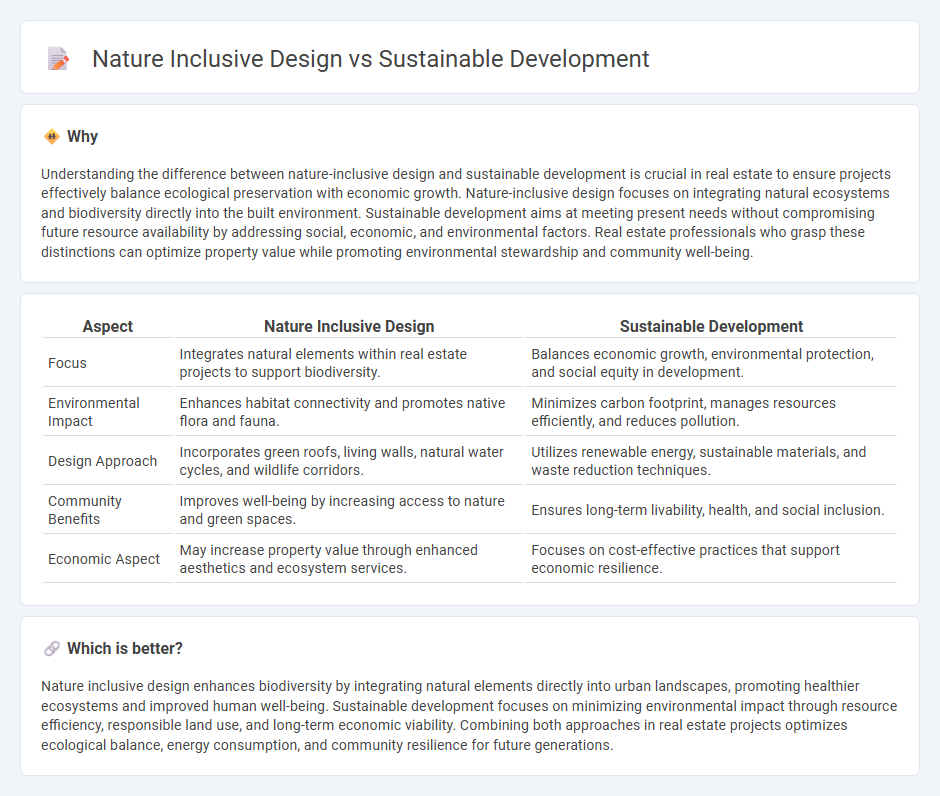
Nature-inclusive design integrates natural ecosystems into real estate developments, enhancing biodiversity and promoting healthier living environments compared to traditional models. Sustainable development in real estate focuses on long-term environmental responsibility by minimizing carbon footprints, optimizing resource efficiency, and ensuring economic viability. Explore more to understand how these approaches redefine future urban planning and property value.
Why it is important
Understanding the difference between nature-inclusive design and sustainable development is crucial in real estate to ensure projects effectively balance ecological preservation with economic growth. Nature-inclusive design focuses on integrating natural ecosystems and biodiversity directly into the built environment. Sustainable development aims at meeting present needs without compromising future resource availability by addressing social, economic, and environmental factors. Real estate professionals who grasp these distinctions can optimize property value while promoting environmental stewardship and community well-being.
Comparison Table
| Aspect | Nature Inclusive Design | Sustainable Development |
|---|---|---|
| Focus | Integrates natural elements within real estate projects to support biodiversity. | Balances economic growth, environmental protection, and social equity in development. |
| Environmental Impact | Enhances habitat connectivity and promotes native flora and fauna. | Minimizes carbon footprint, manages resources efficiently, and reduces pollution. |
| Design Approach | Incorporates green roofs, living walls, natural water cycles, and wildlife corridors. | Utilizes renewable energy, sustainable materials, and waste reduction techniques. |
| Community Benefits | Improves well-being by increasing access to nature and green spaces. | Ensures long-term livability, health, and social inclusion. |
| Economic Aspect | May increase property value through enhanced aesthetics and ecosystem services. | Focuses on cost-effective practices that support economic resilience. |
Which is better?
Nature inclusive design enhances biodiversity by integrating natural elements directly into urban landscapes, promoting healthier ecosystems and improved human well-being. Sustainable development focuses on minimizing environmental impact through resource efficiency, responsible land use, and long-term economic viability. Combining both approaches in real estate projects optimizes ecological balance, energy consumption, and community resilience for future generations.
Connection
Nature-inclusive design integrates natural ecosystems into urban planning, promoting biodiversity and enhancing ecological resilience. Sustainable development supports this by ensuring resources are used efficiently and buildings minimize environmental impact, aligning with long-term ecological health. Together, they create real estate projects that balance human needs with the preservation of natural habitats.
Key Terms
Green Building
Green building practices integrate sustainable development principles by minimizing environmental impact, enhancing energy efficiency, and promoting resource conservation through innovative materials and technologies. Nature inclusive design emphasizes harmonizing built environments with local ecosystems, fostering biodiversity, and supporting natural processes within urban settings to create resilient, healthy spaces. Discover how combining sustainable development with nature inclusive design transforms green building strategies for a sustainable future.
Biodiversity
Sustainable development promotes balanced economic growth while conserving natural resources, often integrating biodiversity conservation as a key goal. Nature-inclusive design goes a step further by embedding biodiversity into urban planning and architecture, creating habitats that support native species and ecological processes within human environments. Explore how these approaches redefine our relationship with nature and enhance biodiversity conservation.
Ecological Integration
Sustainable development emphasizes balancing economic growth, social inclusion, and environmental protection to meet present and future needs, whereas nature-inclusive design focuses specifically on incorporating natural systems and biodiversity into built environments for enhanced ecological integration. Ecological integration involves creating habitats within urban areas that support pollinators, improve air and water quality, and promote resilience against climate change impacts. Discover practical strategies and innovations driving the synergy between sustainability and nature-inclusive design.
Source and External Links
Wikipedia: Sustainable Development - Sustainable development aims to meet current needs without compromising future generations' ability to meet their own needs, balancing economic, environmental, and social aspects.
International Institute for Sustainable Development: Sustainable Development - Sustainable development involves meeting present needs without jeopardizing future generations' ability to meet their own needs, as defined by the Brundtland Report.
UN Sustainable Development Solutions Network - The SDSN promotes practical solutions for sustainable development by mobilizing knowledge institutions and leveraging their strengths to support action on the Sustainable Development Goals.
 dowidth.com
dowidth.com